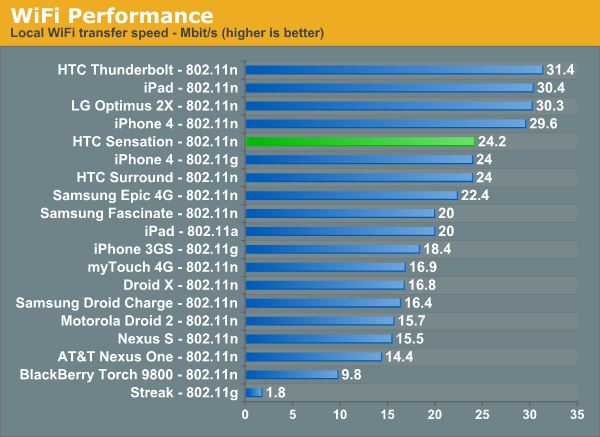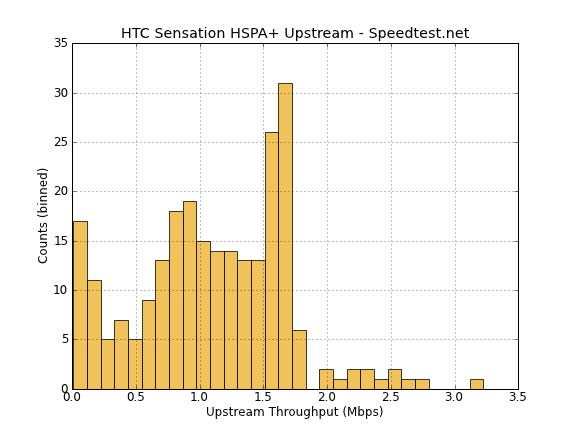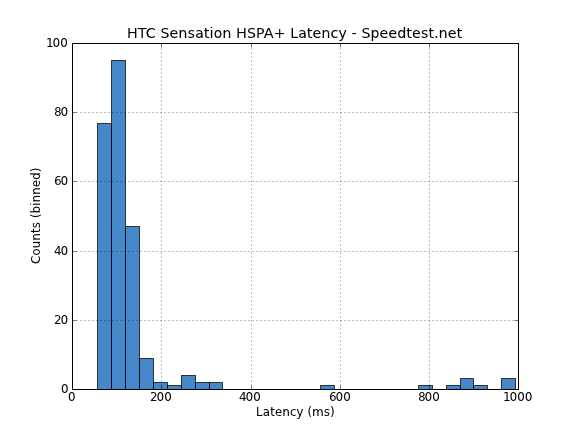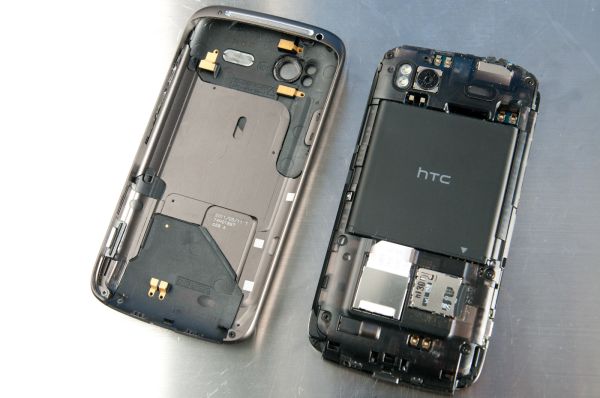HTC Sensation 4G Review - A Sensational Smartphone
by Brian Klug on July 1, 2011 12:38 AM EST- Posted in
- Smartphones
- HTC
- Android
- Mobile
- HTC Sensation
- MSM8260
Connectivity - WiFi and Cellular
The Sensation includes 802.11b/g/n WiFi and uses a Broadcom WLAN stack (likely the ever-popular BCM4329 yet again), I saw it connect at 72 Mbps just like I’m used to seeing for single spatial stream smartphones running 802.11n. Actual WiFi range is good, and largely on par with the iPhone 4 and other devices widely accepted as being decent. I watched Sensation RSSI hover around plus or minus 1 or 2 dBm from an iPhone 4 throughout my house connected to an 802.11n AP.
What’s odd about the Sensation is that to get those numbers required holding the phone portrait. The Sensation doesn’t appear to have a very isotropic antenna, as holding it screen-up yielded less signal than if I held the Sensation with the display facing me.


Before (left) and after (right) having the top portion cupped in the hand - note RSSI changes by 15 dB.
Back with the Desire HD, there was some outcry about the device having its own form of deathgrip, thanks in part to the WLAN antenna being integrated into the battery door and surrounded by metal. Things have improved somewhat with the Sensation, but you can still drop 15 dB by cupping the top plastic area where the WLAN antennas are patterned.
Throughput is likewise decent in our 100+ MB PDF local download test, though it isn’t as super as some other phones of late.

Cellular connectivity on the Sensation is courtesy of the MSM8260’s onboard baseband, which is HSPA+ capable and supports HSDPA 14.4 / HSUPA 5.76 on 900 / 1700 / 2100. There’s quad-band GSM/EDGE support for 850 / 900 / 1800 / 1900 as well. Remember that the x in MSM8x60 denotes which mode is present - 2 for single mode UMTS, 6 for multi mode UMTS and CDMA. The baseband on the MSM8260 is effectively the same modem as what was in MSM8255.
I ran 249 tests on the Sensation connected to T-Mobile’s HSPA+ network. On the Sensation, that shows up with a big bold “4G” logo. When you’ve fallen back to EDGE you get a sans-bold “2G,” and on GPRS just a G. I don’t think there’s much of an argument to be made for HSPA being “4G” until most of the carrier is running dual carrier HSPA or MIMO. Even then, without much faster backhaul and compatible phones, things aren’t going to change much. T-Mobile’s coverage isn’t exactly perfect in my area, but I ran tests whenever I saw HSPA in both Tucson and Phoenix Arizona, and Los Angeles California. Those are all HSPA+ enabled markets, and since the Sensation isn’t a 64QAM device it isn’t like things were faster in one than the other.
There’s a clustering of results at the bottom between 0.5 and 3 Mbps, but there are impressive tests going all the way up to just shy of 10 Mbps. I’ve seen just over 11 Mbps tethered and parked within close line of sight to a T-Mobile cell site. When signal is good, T-Mobile will get you an awesome occasional 9-10 Mbps. When you’re not within line of sight to the tower, (in average coverage), you’ll get that 1-2 Mbps or so. Keep in mind, this is when you’re actually connected to HSPA+ — I did spend considerable time just stuck on EDGE in parts of some markets, and likewise in the wrong parts of town and my house. T-Mobile seems to be pushing the adoption of higher and higher HSDPA and HSUPA categories on its network, including moving to higher order modulation and dual carrier, which deserves applause, but at the same time more cell sites seem a necessity.
The most sensitive cellular region on the Sensation seems to be at the bottom of the back case, which is what we’re used to almost always seeing for smartphones because of how the FCC tests. In addition, the Sensation seems to have Rx diversity, with one antenna up in the top plastic region, one at the bottom. The good bits of the FCC reports are still locked down until around October, but there honestly aren’t too many question marks to fill in with regards to the Sensation.
| Signal Attenuation Comparison in dB - Lower is Better | ||||||||
| Cupping Tightly | Holding Naturally | Holding in Case | On an Open Palm | |||||
| HTC Sensation | 15.0 | 10.0 | 8.0 | 0.0 | ||||
| Samsung Droid Charge | 10.0 | 10.0 | 5.0 | 0.0 | ||||
| HTC Thunderbolt - LTE | 5.3 | 2.5 | - | 4.4 | ||||
| HTC THunderbolt - EVDO | 6.5 | 0.8 | - | 7.2 | ||||
| Verizon iPhone 4 | 16.5 | 15.5 | 9.0 | 7.9 | ||||
| LG Optimus 2X | 13.7 | 9.3 | - | 5.9 | ||||
| Nexus S | 13.3 | 6.1 | - | 4.3 | ||||
| Droid 2 | 11.5 | 5.1 | - | 4.5 | ||||
| BlackBerry Torch | 15.9 | 7.1 | - | 3.7 | ||||
| Dell Streak | 14.0 | 8.7 | - | 4.0 | ||||
| Droid X | 15.0 | 5.1 | - | 4.5 | ||||
| AT&T iPhone 4 | 24.6 | 19.8 | 7.2 | 9.2 | ||||
| iPhone 3GS | 14.3 | 1.9 | 3.2 | 0.2 | ||||
| HTC Nexus One | 17.7 | 10.7 | 7.7 | 6.7 | ||||
Attenuation from holding the phone isn’t a big deal with the Sensation. If anything, I think HTC is due for some well-deserved kudos for trying something different with its latest crop of antenna designs. I’m impressed with how the Desire HD maintained a metal package and hid antennas in plastic RF windows that double as covers, and the Sensation is even more interesting with them being built into the two plastic triangles which snap into the back cover. Of course, if you take the metal exoskeleton off, you lose all signal, but that’s to be expected. I’ve actually taken the cover completely off sometimes and seen EDGE hang on.














107 Comments
View All Comments
mikehunt80 - Friday, July 1, 2011 - link
Yeah, nvidia need a slap for leaving h264 main/high out of their hardware codec in Tegra 2 and not bothering to add Neon.Cardinal sin!
metafor - Friday, July 1, 2011 - link
DICE player allowed you to play 1080p mkv on the Sensation. I've even played Blu-ray rips, though not at really high bitrates (20mbps I believe).ph00ny - Wednesday, July 6, 2011 - link
search button can be triggered by holding the menu button also having the physical home button also means no accidental tiggersnraudigy2 - Saturday, July 9, 2011 - link
S2 will play 1080 Adobe Flash video. Sensation will get up to 720, but G2X and Optimus only play 480p.ph00ny - Wednesday, July 6, 2011 - link
I've been recommending sensation over GSII just so that i will be the only one with GSII...But anyone that has tried both devices have said GSII is noticeably quicker that includes the Tmobile employee that was letting me test drive the device while she played with mine
Chloiber - Friday, July 1, 2011 - link
There are 2 negative points regarding the Sensation which keep me from buying the phone:1. As you mentioned, the space between the display and the case. Many users already got dirt and dust under their display.
2. Choppy performance. It's a dualcore phone and the browser is still very choppy - I can't live with that. I don't buy a DC phone just to see choppy browsing.
At the same time, other high end phones like the Galaxy S2 suffer from huge problems too. The praised display has huge drawbacks. A yellowish tint and gradient from left to right and huge banding issues. It's very well documented on XDA.
I expect those things on mediocre phones. But choppy browsing performance despite a DC SoC or problems with the display (be it dirt or just a crappy display) are a no go for a super high end smart phone for me. So I'll probably wait for the next Nexus.
piroroadkill - Friday, July 1, 2011 - link
Try Opera Mobile.Chloiber - Friday, July 1, 2011 - link
True, Opera mobile is really smooth, even on my Desire. I'm still somewhat disappointed in the browsing experience on stock Sense.Myrandex - Friday, July 1, 2011 - link
That's one of the things I love about Windows Phone 7. The smoothness of the platform, even on older hardware, is amazing. When comparing it with an Android phone back when I purchased (last November) my LG Quantum, and the Android device actually had better hardware, the choppiness was unreal. I would hope that it would be better with these DC phones but it doesn't seem to be the case.Jason
Will Robinson - Friday, July 1, 2011 - link
Nice review guys,wondering why the Samsung Galaxy S wasn't included in any of the benchmarking?